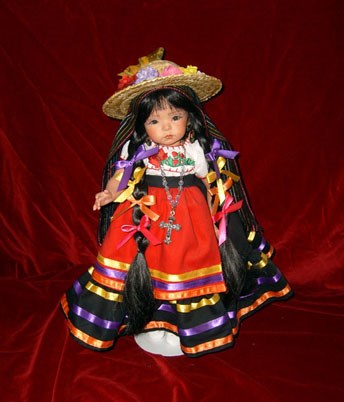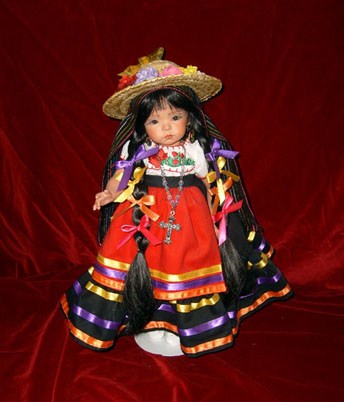
Capital: Morelia A flat-brimmed straw hat topped with flowers fits over a stripped rebozo. The white blouse is embroidered with red roses, and both the long black skirt and red apron are trimmed with brilliant yellow, purple ad orange ribbons. But it's the huge butterfly, as well as the colored ribbons tying off the long braids, that allude to one of Michoacán's most fascinating features. Each November, millions of monarch butterflies leave Canada for their 5,000 kilometer migration to the Monarch Butterfly Sanctuary, a wooded area spanning the border of the state of Mexico and Michoacán. Over the winter, these fragile creatures mature and reproduce before flying north in the spring. The annual phenomenon coincides with Mexico's Day of the Dead; so many believe the butterflies carry the souls of the dead. The majority of Michoacán's indigenous people refer to themselves as Tarascos. The Tarasco, or Purepecha, have integrated successfully with the general population, in large part because of their proximity to heavily populated areas. They subsist through agriculture, especially avocado cultivation; coastal and in-land fishing; and artistic trades. Certain areas and products share the names of the articles in which their artisans specialize: extraordinary copper work comes from Santa Clara del Cobre; the jicaras de Uruapan are small bowls from Uruapan; las guitarras de Paracho are the guitars of Paracho, known as the "guitar capital of Mexico." The state's rich forests provide an abundance of fine woods that generations of skilled luthiers have transformed into excellent musical instruments. Michoacan wears the northern Transversal Volcanic Sierra, also known as the Sierra del Centro, like a crown of rugged peaks. Lush vegetation alternates with the austere beauty of black lava slopes where volcanoes like the Paricutin tower over countless huge craters plunging into the earth. In the central Tierra Caliente, the Marques or Cupatitzio River flowers into midair, producing La Tzarara, a breathtaking waterfall. Michoacán is a major producer of cattle, pork, poultry, milk, eggs, honey and beeswax. The avocado, with its creamy green protein-rich pulp, is a principal agricultural product, and virtually all of Mexico's strawberries are grown in Michoacán and Guanajuato. Coastal fishing yields morjarra, carp, charal, shark, red snapper, crabs, turtles, and oysters. The state's mines produce gold, silver, copper, lead, iron, zinc, and barite. As with other southern states, traces of influence from African immigration are apparent in Michoacán in everything from the marimba (which originated in Africa), to mulattos (people of mixed race). Did You Know? One explanation of the name Michoacán goes back to Michamacuan, a province near what is now Patzuaro. Its center was called Tzintzuntzan, which means "next to the water," and its fishermen inhabitants were known as Michoaques, or people from Mechoacan, which means, "where there are many fish," or "the place of the fishermen." Hernan Cortes, the Spanish captain who conquered Mexico, spoke of the Purepecha kingdom as the Province of Mechoacan. With the passage of time, this place gradually became known as Michoacán in Spanish. Many years later, native-born Melchor Ocampo became governor, thus the name Michoacán de Ocampo. 
Capital: Morelia Este traje típico se compone de un sombrero de paja adornado con flores que se sostiene a la cabeza por un rebozo rallado. La blusa blanca bordada con rasas rojas, la falda larga negra y el delantal rojo se ajustan a la cintura con brillantes listones amarillos, púrpuras y naranjas; las trenzas también van sujetas por colorido listones. Cada noviembre, la mariposa Monarca sale de Canadá al Santuario de la Mariposa Monarca recorriendo una distancia de 5,000 kilómetros a pasar el invierno. Durante esta época estas craturas frágiles maduran y se reporducenantes de partir hacia el norte en la primavera. Esta área boscosa se encuentra entre la frontera de México y Michoacán. El fenómeno anual coincide con el Día de los Muertos en México, por esta razón muchos creen que las mariposas llevan las almas de los muertos. La mayoría de la gente indígena de Michoacán se llama Tarascos. Los Tarascos o Purépechas, se han integrado satisfactoiamente a la población general, en gran parte debido a su proximidad a áreas densamente pobladas. Subsisten gracias a la agricultura, sobre todo el cultivo del aguacate, pesca costera e interior y labores artísticas. Algunas regiones y productos comparten el nombre de los artículos en los cuales el artesano se especializa: el extraordinario trabajo de cobre proviene de Santa Clara del Cobre; las jícaras de Uruapan son pequeñas tazones de Uruapan; las guitarras de Paracho son de la region de Paracho, conocida como "La capital mexicana de la guitarra". Los ricos bosques del estado proporcionan abundantes maderas finas que expertos artesanos transforman en excelentes instrumentos musicales. Michoacán aloja a la Sierra Transversal Volcánica, también conocida como Sierra del Centro. La exuberante vegetación alterna con la bellexa frugal de los desniveles causados por la lava negra, donde volcanes como el Paricutín emergen de la tierra. En el centro de Tierra Caliente, el Río Marqués o el Río Cupatitzio forma una impresinante cascada llamada La Tzarára. Michoacán es productor principal de ganado, carne de cerdo, aves de corral, leche, huevos, miel y cera de abeja. El aguacate, con su pulpa cremosa verde, rica en proteínas, es el producto principal agrícola y prácticamente las fresas de todo México son cultivadas en Michoacán y Guanajuato. Producciones costeras de pesca incluyen: mojarra, carpa, charal, tiburón, cangrejos, tortugas, y ostras. Las minas del estado producen oro, plata, cobre, plomo, hierro, y zinc. Sabías que...? |
Last updated: February 24, 2015
